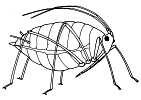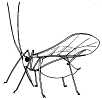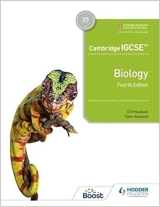Aphids, an Introduction
The aphids are probably best known as "greenfly" on roses or "blackfly" on broad beans. They belong to a group of insects known as "bugs" or Hemiptera, the mouth parts of which are modified to form piercing and sucking tubes, the insects obtaining their food by sucking plant juices or the blood of other animals. Water boatmen, for example, are Hemipterans which prey on other pond creatures; the frog-hoppers and "cuckoo-spit" insects draw fluids from plants. This group of insects has an incomplete metamorphosis, there being no pupal stage but a series of moults in which the nymph gradually becomes a mature adult.
There are over 400 species and varieties of aphids but the account given below applies in general to those commonly encountered as garden and orchard pests.
Life history. In October the females lay eggs usually on the stems of trees or shrubs. The eggs are black, with thick shells and can withstand extremes of temperature. It is in the egg form only that aphids pass the winter. In March the eggs hatch out into wingless female nymphs which are similar to the adults, with three pairs of legs, compound eyes, antennae, etc. There is no larval or pupal stage comparable to those of the butterfly, but with successive moults and continuous growth the nymphs become mature females. No males are hatched at all.
The female nymphs feed on the shoots and leaves of the tree on which they hatch, at the time when the buds are sprouting. After a series of ecdyses (moults) they become mature and give birth to daughter aphids without any fertilization. This kind of reproduction is called parthenogenesis. The daughters, moreover, are not produced from eggs but are born alive as nymphs though they are surrounded at first by a transparent capsule like an egg membrane.
The daughters grow quickly and themselves have offspring by parthenogenesis. Some of these develop wings which grow larger at each ecdysis. These winged daughters fly off to an herbaceous plant such as a rose tree or bean plant. The winged forms have two pairs of wings of which the hind pair are quite small. Both pairs are transparent with few veins. The aphids are not strong fliers but tend to be carried by chance air currents rather than make direct flights. Spruce aphids were once found in Spitsbergen, and are thought to have been carried in the upper air some 800 miles across the sea from Russia where the nearest spruce trees grow.
When the winged generation reach the new food plant they give birth to wingless daughters parthenogenetically. In warm weather these may mature in 8 to 10 days and begin to reproduce in the same way by bearing winged daughters which fly off and infest new plants. This process of parthenogenesis goes on all through the summer months, winged and wingless generations more or less alternating. Enormous numbers of aphids are produced in this way, though a great many are killed by birds, ladybirds and their larvae, lace-wing larvae, and cold weather.
In October the first males appear. They have wings, and fly to a tree. Winged females fly to the same tree and there give birth to wingless daughters. The males mate with these when mature, and the wingless females subsequently lay eggs on the twigs of the tree. The eggs remain dormant until the following spring when the tree buds begin to sprout.
Feeding habits. Nymphs and adults feed in the same way. Their mouth parts consist of a slender tube with two sharp stylets running down each side. All these are enclosed in the sheath-like labium and are held horizontally below the thorax when not in use. During feeding the labium is bent and shortened as the stylets and central tube are pushed through the epidermis of the leaf or stem until they reach the sieve tubes of the phloem in a vascular bundle. Saliva is injected through the puncture to begin the digestion of the sap and cytoplasm, and the fluids are then pumped up by muscular movements of the gullet into the alimentary canal. The fluid pressure existing in most plant cells probably assists the flow of liquid through the aphid's mouth parts. Most aphids seem to take in from the plant sap more sugar than they can assimilate, so that their faeces consist of a sweet syrup, honey dew, that is passed out of the anus. Some species of ant like to feed on this exudation and may be seen clambering over the colonies of aphids on nettles and other plants to collect it. Other species of ants ‘farm’ aphids by keeping them in the nest below ground where they suck fluids from roots, the ants then collecting the honey dew as it is egested.
Damage and control. A large number of aphids on the growing shoots of a plant can cause damage, partly by the excessive removal of food that would otherwise pass to the growing leaves, partly by the digestive action of the saliva injected and also by introducing virus diseases from one plant to another, particularly in the potato, sugar beet and sugar cane. Young leaves attacked by aphids usually curl up and wither and the growth of the entire shoot may be arrested.
Aphids can be destroyed by spraying them with solutions or suspensions containing insecticides which kill them on contact. Covering the leaves with poisons is useless because the aphid draws its food from below the surface. For this reason systemic insecticides are often used. These are absorbed into the plant tissues so that the aphids are poisoned when they ingest the plant juices. Once the leaves have curled up under a heavy aphid attack it is difficult to reach the insects with sprays. A less direct method of control in winter is to spray the trees in the garden or orchard where the autumn eggs have been laid. Poisons dissolved in water run off the thick shell, so solvents such as paraffin, and liquids such as tar oil, are used, these penetrating the shell and destroying the egg. This must be done before the foliage develops, otherwise the sprays will damage the leaves.
Larval and adult ladybirds eat a great many aphids, and an ichneumon parasite causes many deaths by laying its eggs in the bodies of the aphids. These predators, parasites and spells of cold weather help keep down the numbers of aphids.
For illustrations to accompany this article see Insect Life-Cycles| Search this site |
| Search the web |
© Copyright D G Mackean & Ian Mackean. All rights reserved.



